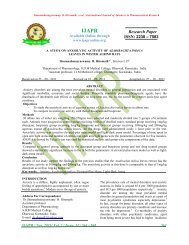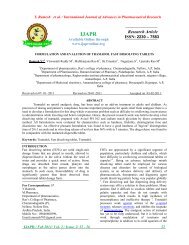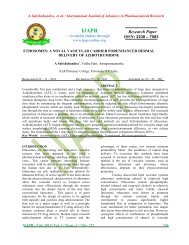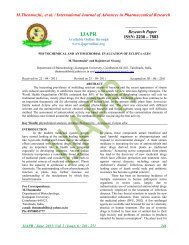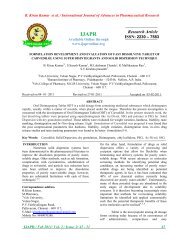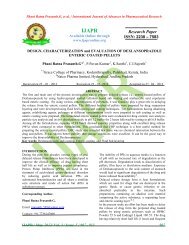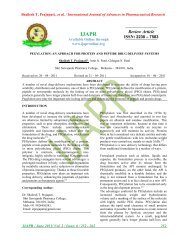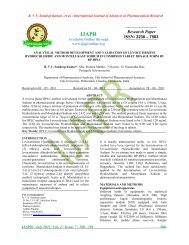formulation and characterizatin of transdermal patches by using ...
formulation and characterizatin of transdermal patches by using ...
formulation and characterizatin of transdermal patches by using ...
Create successful ePaper yourself
Turn your PDF publications into a flip-book with our unique Google optimized e-Paper software.
N.Sureshbabu et al. / International Journal <strong>of</strong> Advances in Pharmaceutical Research<br />
IJAPR<br />
Available Online through<br />
www.ijapronline.org<br />
Research Paper<br />
ISSN: 2230 – 7583<br />
DEVELOPMENT OF FIXED DOSE COMBINATION OF ANTI-RETROVIRAL DRUGS<br />
CONTAINING LAMIVUDINE, NEVIRAPINE AND ZIDOVUDINE IN THE FORM OF<br />
A DISPERSIBLE TABLET FOR PEDIATRIC USE<br />
N.Sureshbabu* 1 , Dr.M.SenthilKumar 1 , Dr.V.Sreenivasulu 2 , S.Valarmathi 1 , S.Srinivas Naidu 1 ,<br />
Kasam Naveen Kumar 3 , D.Hariharan 1 .<br />
1 Annai Veilankannie’s Pharmacy College, Chennai-17, India<br />
2 Sri Lakshmi Venkateswara Institute <strong>of</strong> Pharmaceutical Sciences, Prodduturu, A.P, India<br />
3 Department <strong>of</strong> Pharmaceutics, SLC’S College <strong>of</strong> Pharmacy, Hyderabad, India<br />
Received on 22 – 07 - 2012 Revised on 18 – 08- 2012 Accepted on 25– 08 – 2012<br />
ABSTRACT<br />
In AIDS therapy, mono therapy is not recommended because incomplete viral suppression can lead to development<br />
<strong>of</strong> resistance. Combinations <strong>of</strong> antiretrovirals create multiple obstacles to HIV replication to keep the number <strong>of</strong><br />
<strong>of</strong>fspring low <strong>and</strong> reduce the possibility <strong>of</strong> a superior mutation. The present investigation reports development <strong>of</strong> an<br />
in-vitro dispersible fixed dose combination tablet containing Lamivudine(30mg), Nevirapine(50mg) <strong>and</strong><br />
Zidovudine(60mg). The dispersible tablet is intended for ease <strong>of</strong> administration, primarily to pediatric patients. The<br />
tablets were prepared <strong>by</strong> wet granulation techanique <strong>and</strong> evaluated for various parameters like weight variations,<br />
hardness, friability, disintegration time, assay, related impurities <strong>and</strong> dissolation pr<strong>of</strong>ile. The optimized <strong>formulation</strong><br />
contains 12% <strong>of</strong> Lamivudine, 20% <strong>of</strong> Nevirapine <strong>and</strong> 24% <strong>of</strong> Zidovudine as active ingredients, 24.8% <strong>of</strong> Lactose<br />
monohydrate <strong>and</strong> 8% <strong>of</strong> Microcrystalline Cellulose as diluent, 5.2% <strong>of</strong> Sodium Starch Glycolate as disintegrant,<br />
1.4% silicon dioxide as Glidant, 1.6% Sucralose as sweetener, 0.8% strawberry flavor 1% <strong>of</strong> povidone as binder<br />
<strong>and</strong> 1.2% <strong>of</strong> magnesium stearate as lubricant. The optimized <strong>formulation</strong> had a weight variation < 10%, hardness <strong>of</strong><br />
35-50N, percentage friability <strong>of</strong> 0.15, disintegration time <strong>of</strong> 55-60 sec, % assay was 102.2% for Lamivudine,<br />
99.9% for Nevirapine <strong>and</strong> 102.5% for Zidovudine <strong>and</strong> in vitro drug release after 30mins was 100.2 % for<br />
Lamivudine, 99.9% for Nevirapine <strong>and</strong> 100.1% for Zidovudine. Tablets were packed in HDPE containers for<br />
stability study. The <strong>formulation</strong> was stable after three month <strong>of</strong> accelerated stability studies.<br />
Key Words: AIDS, HIV, Dispersible tablets, fixed dose combination, Lamivudine, Nevirapine, wet granulation,<br />
Zidovudine.<br />
INTRODUCTION<br />
The number <strong>of</strong> people living with HIV/AIDS has<br />
risen from around 8 million in 1990 to more than 33<br />
million <strong>and</strong> is still growing. More than 25 million<br />
people have died <strong>of</strong> AIDS since 1981 <strong>and</strong> there is no<br />
immediate cure to curb such untimely deaths. India<br />
has a population <strong>of</strong> more than one billion; around<br />
half <strong>of</strong> them are adults in sexually active group.<br />
Address for Correspondence<br />
N.Sureshbabu<br />
Department <strong>of</strong> Pharmaceutics<br />
Annai Veilankanni’s Pharmacy College<br />
Chennai-17<br />
Mail I d:sureshpharma2012@yahoo.com<br />
The first AIDS in India was detected in 1986, since<br />
then HIV infection has been reported all over the<br />
country. As <strong>of</strong> July 2011 revised estimate, now 3<br />
million people in India are living with AIDS 1 .<br />
During this decade, effective therapies aimed at<br />
continued suppression <strong>of</strong> HIV replication <strong>and</strong><br />
targeted at resting HIV reservoirs such as brain,<br />
lymphatic systems will be critical to prolong survival<br />
<strong>and</strong> renewing hopes for a cure. Thus goals <strong>of</strong><br />
antiretroviral therapy include, reducing the<br />
symptoms <strong>of</strong> HIV infection <strong>and</strong> delay disease<br />
progression to AIDS. Established HIV infection is<br />
diagnosed <strong>by</strong> finding antibodies to HIV in the<br />
plasma <strong>using</strong> various serological testing methods<br />
IJAPR / Sept. 2012/ Vol. 3 /Issue. 9 / 1116 – 1130 1116
N.Sureshbabu et al. / International Journal <strong>of</strong> Advances in Pharmaceutical Research<br />
such as ELISA, Orasure western blot, SUDS,<br />
Orasure HIV-1. Generally according to the United<br />
States Food <strong>and</strong> Drug Administration <strong>and</strong> World<br />
Health Organization guidelines, the antiretroviral<br />
therapy is commenced with these observations, such<br />
as when patients experience severe symptoms <strong>of</strong><br />
HIV infection or have been diagnosed with AIDS or<br />
when the viral load in the blood sample is found to<br />
be 50,000 copies/ml or more or when the CD4 cell<br />
count is less than 200-350 cells/mm 3 . 1<br />
Antiretroviral drugs are broadly classified<br />
<strong>by</strong> the phase <strong>of</strong> the retrovirus life cycle that the drug<br />
inhibits 1,3,4 .<br />
‣ Nucleoside <strong>and</strong> nucleotide reverse<br />
transcriptase inhibitors(NRTI) inhibits<br />
reverse transcription <strong>by</strong> being incorporated<br />
into the newly synthesized viral DNA <strong>and</strong><br />
thus preventing further elongation<br />
Examples: Abacavir, Emtricitabine,<br />
Ten<strong>of</strong>ovir, Lamivudine, Didanosine,<br />
Stavudine, Zidovudine, Amdoxovir<br />
‣ Non nucleoside reverse transcriptase<br />
inhibitor (NNRTI) inhibits reverse<br />
transcriptase <strong>by</strong> directly binding to the<br />
enzymes <strong>and</strong> thus interferes with its<br />
function. Examples: Efavirenz, Nevirapine,<br />
Etravirine, Rilpivirine<br />
‣ Protease inhibitors (PI) targets viral<br />
assembly <strong>by</strong> inhibiting the activity <strong>of</strong><br />
protease, an enzyme used <strong>by</strong> HIV to cleave<br />
nascent proteins for final assembly <strong>of</strong> new<br />
virons. Examples: Ritonavir, Saquinavir,<br />
Lopinavir, Fosamprenavir, Saquinavir,<br />
Atazanavi.<br />
‣ Integrase inhibitors (IT) inhibit the<br />
enzyme integrase, which is responsible for<br />
integration <strong>of</strong> viral DNA into the DNA <strong>of</strong><br />
infected cell. Examples: Elvitegravir,<br />
Raltegravir.<br />
‣ Entry inhibitors or Fusion inhibitors (FI)<br />
interferes with binding, fusion <strong>and</strong> entry <strong>of</strong><br />
HIV-1 to the host cell <strong>by</strong> blocking one <strong>of</strong><br />
several stages. Examples: Maraviroc,<br />
Enfuvirtide, Vicriviroc<br />
Combination therapy<br />
Mono-therapy is no longer recommended because<br />
incomplete viral suppression can encourage<br />
development <strong>of</strong> resistance. Similarly, magnitude <strong>and</strong><br />
durability <strong>of</strong> viral suppression is lower with dual<br />
antiretroviral combinations compared with<br />
combinations containing three or more agents. For<br />
example, generally two NRTIs are combined with<br />
antiretroviral from PI or NNRTI class. Similarly,<br />
mono-therapy with PI or NNRTI is also not<br />
advisable in order to prevent the emergence <strong>of</strong><br />
resistance <strong>and</strong> subsequent drug failure.<br />
In the present study, a combination <strong>of</strong> Lamivudine<br />
/Nevirapine/Zidovudine (30mg/50mg/60mg) has<br />
been used to develop in vitro dispersible tablet for<br />
pediatrics use. Since the dose <strong>of</strong> three active<br />
ingredients was more, it is a challenge to<br />
successfully formulate an in- vitro dispersible tablet<br />
<strong>using</strong> limited choice <strong>and</strong> concentration <strong>of</strong> excipients.<br />
In the present study Lactose monohydrate <strong>and</strong> MCC<br />
was used as diluents, SSG used as disintegrant,<br />
Povidone as binder, Colloidal silicon dioxide as<br />
Glidant, Sucralose as sweetener, strawberry as flavor<br />
<strong>and</strong> Mg.St as lubricant. 7<br />
MATERIALS AND METHODS<br />
Lamivudine, Nevirapine, Zidovudine, Lactose<br />
monohydrate, MCC, SSG, Povidone, Colloidal<br />
silicon Di oxide, Strawberry flavour, Mg Stearate<br />
Procured from Alchem Murugan Suppliers Chennai.<br />
Pre<strong>formulation</strong><br />
The following are the pre<strong>formulation</strong> studies<br />
conducted on the active pharmaceutical ingredients:<br />
‣ Description<br />
‣ Solubility<br />
‣ Identification <strong>by</strong> IR, HPLC, DSC<br />
The pre<strong>formulation</strong> parameters considered for<br />
<strong>formulation</strong> aspects are:<br />
‣ Melting point<br />
‣ Bulk density<br />
‣ Tapped density<br />
‣ Particle size analysis<br />
‣ Drug-excipients compatibility studies<br />
Description<br />
Powder was assessed for color, odour,<br />
taste, hydroscopicity, etc.<br />
Solubility: The solubility studies were carried out<br />
for all the three API’s in distilled water <strong>and</strong> also with<br />
other solvents <strong>by</strong> adding excess amount <strong>of</strong> the drug<br />
in to the flask in each case <strong>and</strong> keeping the flask on a<br />
shaker.<br />
Identification <strong>by</strong> IR spectroscopy<br />
IR spectra <strong>of</strong> the pure drug taken in KBr at<br />
moderate scanning speed.<br />
Bulk density <strong>and</strong> Tapped density<br />
Bulk density (D b ) ═ Mass <strong>of</strong> the powder (M) /<br />
Bulk volume (V b )<br />
Tapped density (D t ) ═ Mass <strong>of</strong> the powder (M)<br />
/ Tapped volume (V T )<br />
The Carr ’ s index is the measure <strong>of</strong> propensity <strong>of</strong> the<br />
powder to be compressed. It is calculated <strong>using</strong> the<br />
formula given below.<br />
Carr ’ s index (CI) ═ (D t – D b ) / D t × 100<br />
IJAPR / Sept. 2012/ Vol. 3 /Issue. 9 / 1116 – 1130 1117
N.Sureshbabu et al. / International Journal <strong>of</strong> Advances in Pharmaceutical Research<br />
Angle <strong>of</strong> repose<br />
It is the maximum angle possible between the<br />
surface <strong>of</strong> a pile <strong>of</strong> the powder <strong>and</strong> the horizontal<br />
plane.<br />
Tan θ =h/r<br />
Where,<br />
h = height in cms<br />
r = radius in cms<br />
Compatibility studies<br />
The drug <strong>and</strong> excipients were mixed as per table 4.4<br />
<strong>and</strong> were distributed equally in 10ml moulded glass<br />
vials with 20mm grey coloured rubber plugs. They<br />
were loaded for stability study at 25 ± 2 0 C / 60 ±<br />
5%RH <strong>and</strong> 40 ± 2 0 C / 75 ± 5% RH. The samples<br />
were drawn in the intervals <strong>of</strong> zero (initial) <strong>and</strong><br />
fourth week <strong>and</strong> analyzed for drug stability <strong>by</strong> HPLC<br />
method.<br />
Precompression parameters:<br />
Following properties were evaluated as<br />
Precompression parameters<br />
‣ Loss on drying<br />
‣ Bulk density<br />
‣ Tapped density<br />
‣ Particle size distribution<br />
Compression parameters:<br />
Following parameters were evaluated during<br />
compression<br />
‣ Average weight<br />
‣ Hardness test<br />
‣ Friability test<br />
‣ Disintegration test<br />
‣ Dissolution<br />
Post compression parameters:<br />
Following parameters were evaluated as<br />
post compression parameters<br />
‣ Physical parameters like Bulk density,<br />
Tapped density <strong>and</strong> Carr’s index<br />
‣ Disintegration<br />
‣ Assay<br />
‣ Related substances<br />
‣ Dissolution<br />
Formulation development:<br />
RESULTS AND DISCUSSION<br />
Drug – Excipients compatibility studies were<br />
performed for a period <strong>of</strong> 4 weeks at 40±2 0 C/75±5%<br />
RH. The results showed that the impurities were<br />
found to be with in limit. The results are shown in<br />
Table 5.4. The impurities were compared with<br />
samples (Table 5.4), <strong>and</strong> found with in the limit.<br />
From this we can conclude that there was no<br />
interaction between lamivudine,nevirapine <strong>and</strong><br />
zidovudine with selected excipients.<br />
‣ F-1 was dropped as poor flow<br />
properties, torrent sticking to<br />
punches.<br />
‣ Dispersion in the water is poor.<br />
‣ This (F-2) was <strong>formulation</strong><br />
dropped as sticking problem was<br />
observed.<br />
‣ So wet granulation is selected for<br />
next <strong>formulation</strong>.<br />
In the third <strong>formulation</strong> F-3 (Table 4.9) the wet<br />
granulation was selected <strong>using</strong> Cros-povidone as a<br />
disintegrating agent, used both intra <strong>and</strong> extra<br />
granularly. The granulation was done <strong>using</strong> FBP.<br />
Dispersion in water was satisfactory <strong>and</strong> taste was<br />
bl<strong>and</strong>. However, <strong>formulation</strong> F-3 was dropped as rat<br />
hole was observed during compression in hopper &<br />
slight sticking to lower punch. The fourth<br />
<strong>formulation</strong> F-4 (Table 4.9) wet granulation was<br />
done RMG <strong>using</strong> cross-povidone as disintegrating<br />
agent, in both intra <strong>and</strong> extra granulation process.<br />
The approach was dropped as flow <strong>of</strong> the granules<br />
was poor. So next <strong>formulation</strong> including excipients<br />
which increase flow.<br />
In the fifth <strong>formulation</strong> F-5(Table 4.10),<br />
povidone was used as a binder <strong>and</strong> CCS used as a<br />
binder. Flow property <strong>of</strong> granules was satisfactory<br />
<strong>and</strong> taste <strong>of</strong> dispersion was sweet so sucralose to be<br />
used for further batches. This <strong>formulation</strong> F-5 was<br />
dropped as after dispersion in water slight bigger<br />
granules settled at the bottom. So Polyplasdone Xl-<br />
10 used as a disintegrate in the next batch.<br />
The sixth <strong>formulation</strong> F-6(Table 4.11) the<br />
average weight <strong>of</strong> tablet was increased to 250mg<br />
from 220mg <strong>using</strong> lactose monohydrate as a diluent<br />
<strong>and</strong> Polyplasdone Xl-10 used as disintegrant,<br />
granulation was done in RMG. Granules flow was<br />
satisfactory so granulation was carried out in RMG<br />
was further batch. Dispersion in water gave<br />
flavoured, sweet taste strawberry flavour was used<br />
for further batch. Few granules were retained after<br />
pouring on 30# mesh. The weight <strong>of</strong> tablet increased<br />
to 250mg for further batch this approach was<br />
dropped as rat hole in the hopper is observed <strong>and</strong><br />
sticking to lower punch is observed.<br />
The seventh <strong>formulation</strong> F-7 (table 4.12)<br />
was <strong>by</strong> changing the disintegrate (SSG) used,<br />
dispersion in water is good it took 1 min disintegrate<br />
in water <strong>and</strong> dispersion passing through #30 mesh.<br />
Dispersion in water gave flavoured, sweet taste <strong>and</strong><br />
flow <strong>of</strong> granules is good. The stability data for 3<br />
moths studied the amount <strong>of</strong> impurity within the<br />
limit <strong>and</strong> drug release is more 80% within 15 min. so<br />
this batch is optimized.<br />
Post compression parameters <strong>of</strong> F-7 were as<br />
follows,<br />
Average weight: The average weight <strong>of</strong> the tablet<br />
was 250 mg.<br />
Thickness: The thicknesses <strong>of</strong> the tablets were<br />
found between 3.0mm to 3.2mm.<br />
IJAPR / Sept. 2012/ Vol. 3 /Issue. 9 / 1116 – 1130 1118
N.Sureshbabu et al. / International Journal <strong>of</strong> Advances in Pharmaceutical Research<br />
Hardness: The hardness <strong>of</strong> all <strong>formulation</strong>s was<br />
between 35 – 50 N.<br />
Friability: Friability <strong>of</strong> the tablet is not the <strong>of</strong>ficial<br />
test but required for the shipment <strong>of</strong> the product. The<br />
percentage <strong>of</strong> friability <strong>of</strong> the final lab scale<br />
<strong>formulation</strong> (F-7) was not more than 0.15% which<br />
was within the limit (NMT 1%).<br />
Weight variation: As the weight <strong>of</strong> the tablet is<br />
250.0mg the accepted variation is ± 2% <strong>and</strong> it was<br />
found that all the successful <strong>formulation</strong>s were<br />
within the limits.<br />
In-Vitro Dissolution study: The % CDR after<br />
15minute was more than 80%.<br />
Assay: The percentage drug content was found to be<br />
within 90.0% to 105%.<br />
Disintegration time: The disintegration time <strong>of</strong> All<br />
the <strong>formulation</strong>s were evaluated <strong>and</strong> results are<br />
represented in table no 5.7. The disintegration time<br />
should not be more than 3 minutes for tablets. Based<br />
on the Precompression <strong>and</strong> post compression<br />
parameters F-7 was optimized. After obtaining the<br />
stability reports, scale up batch was performed with<br />
bigger batch size 10,000 tablets.<br />
Stability studies: F–7 were subjected for stability<br />
studies <strong>and</strong> was analyzed for physical appearance,<br />
drug content, dissolution pr<strong>of</strong>ile <strong>and</strong> related<br />
substances.<br />
Physical appearance: It was found that<br />
there was no significant change in the color,<br />
visual appearance in all the tablets during<br />
<br />
1 st , 2nd <strong>and</strong> 3 rd month stability study.<br />
Disintegration: There was no significant<br />
difference in DT w.r.t. initial DT.<br />
Drug content: The drug content in F -8<br />
showed no significant change w.r.t. to<br />
initial values.<br />
Dissolution pr<strong>of</strong>ile: Dissolution was<br />
carried out for F – 7 at the intervals 1 st 2 nd<br />
<strong>and</strong> 3 rd months <strong>and</strong> it was found that there<br />
were no significant changes.<br />
Hence, the developed dispersible tablet <strong>of</strong> LNZ <strong>of</strong><br />
formula (F-7) was suitable from pre-compression<br />
characteristics including dispersion time (DT) <strong>and</strong><br />
also stable over 3- months<br />
CONCLUSION<br />
In the present study, an attempt was made to<br />
formulate a FDC tablet having three ARV drugs. The<br />
ARV drugs were Nevirapine an NNRTI, Lamivudine<br />
an NRTI <strong>and</strong> Zidovudine an NRTI. From the study<br />
carried out, following conclusions were made as<br />
given below:<br />
‣ FT-IR studies revealed that there is no<br />
chemical interaction between LNZ <strong>and</strong> the<br />
excipients used in the study.<br />
‣ The tablets prepared were found to be good<br />
without any chipping, capping <strong>and</strong> sticking<br />
‣ Formulated tablets gives satisfactorily result<br />
for various physico-chemical evaluations <strong>of</strong><br />
tablets like tablet dimension, hardness,<br />
friability, weight variation, in vitro<br />
dispersion time, wetting time <strong>and</strong> drug<br />
content.<br />
‣ Based on in vitro dispersion time,<br />
<strong>formulation</strong> F 7 were found to be promising<br />
<strong>and</strong> displayed a dispersion time <strong>of</strong><br />
approximately 55-60 s.<br />
‣ Initial Analysis <strong>using</strong> Simultaneous<br />
estimation <strong>by</strong> HPLC method was possible<br />
to show promising assay results.<br />
‣ In vitro release pr<strong>of</strong>ile <strong>of</strong> the dispersible<br />
tablets were satisfactory <strong>and</strong> complete drug<br />
release was achieved within 30 minutes.<br />
‣ The drug release pr<strong>of</strong>ile compared with<br />
individual drug liquid oral suspension form<br />
<strong>of</strong> available marketed products. So it’s same<br />
as marketed product.<br />
‣ The dosage form was optimized with<br />
respect to <strong>formulation</strong> <strong>and</strong> processing<br />
parameters, which indicated that<br />
<strong>formulation</strong> F-7, was having the desired<br />
optimum characteristics for taking up<br />
stability studies.<br />
‣ Stability studies were carried out as per ICH<br />
guidelines. After 3 months <strong>of</strong> accelerated<br />
stability studies, it was found that the F-7<br />
was sufficiently stable.<br />
‣ After successfully optimizing the<br />
<strong>formulation</strong>, scale up batch was taken <strong>by</strong><br />
increasing the batch size.<br />
Table: 1 - Compositions for compatibility study<br />
Sl.No Combination Composition code<br />
01 Lamivudine+ Nevirapine+ Zidovudine A<br />
02 Lamivudine+ Nevirapine+ Zidovudine + lactose monohydrate + MCC+ B<br />
SSG+ Povidone + Colloidal silicon di oxide+ Mg-st+ Strawberry flavor<br />
03 Lamivudine+Nevirapine+ Zidovudine+Lactose monohydrate C<br />
04 Lamivudine+ Nevirapine+ Zidovudine+MCC D<br />
05 Lamivudine+nevirapine+zidovudine+SSG E<br />
IJAPR / Sept. 2012/ Vol. 3 /Issue. 9 / 1116 – 1130 1119
N.Sureshbabu et al. / International Journal <strong>of</strong> Advances in Pharmaceutical Research<br />
Table-2: Formulation <strong>of</strong> F-1<br />
Sl/no Ingredients Qty/unit(mg)<br />
1 Lamivudine 30<br />
2 Nevirapine 50<br />
3 Zidovudine 60<br />
4 MCC-200 62<br />
5 CCS 12<br />
6 Sucralose 2<br />
7 Purified talc 2<br />
8 Magnesium stearate 2<br />
Table: 3- Formulation <strong>of</strong> F- 2<br />
Sl/no Ingredients Qty/unit(mg)<br />
1 Lamivudine 30<br />
2 Nevirapine 50<br />
3 Zidovudine 60<br />
4 MCC-200 62<br />
5 CCS 12<br />
6 Sucralose 2<br />
7 Purified talc 2<br />
8 Colloidal silicon dioxide 2<br />
9 Magnesium stearate 2<br />
Table: 4 Formulation <strong>of</strong> F- 3 (1-5 intragranular <strong>and</strong> 6-11 extra granular)<br />
Sl/no Ingredients Qty/unit (mg)<br />
1 Lamivudine 30<br />
2 Nevirapine 50<br />
3 Zidovudine 60<br />
4 Cross Povidone 6<br />
5 MCC 40<br />
6 Sucralose 3<br />
7 MCC-200 19<br />
8 Cross Povidone 6<br />
9 Colloidal silicone dioxide 2<br />
10 Purified talc 2<br />
11 Magnesium stearate 2<br />
Table: 5- Formulation <strong>of</strong> F- 4 (1-5 intragranular <strong>and</strong> 6-11 extra granular)<br />
Sl/no Ingredients Qty/unit(mg)<br />
1 Lamivudine 30<br />
2 Nevirapine 50<br />
3 Zidovudine 60<br />
4 MCC(101) 40<br />
5 Purified water Q S<br />
6 Sucralose 5<br />
7 MCC 19<br />
8 Cross-povidone 12<br />
9 Colloidal silicone dioxide 2<br />
10 Magnesium stearate 2<br />
IJAPR / Sept. 2012/ Vol. 3 /Issue. 9 / 1116 – 1130 1120
N.Sureshbabu et al. / International Journal <strong>of</strong> Advances in Pharmaceutical Research<br />
Table:6 - Formulation <strong>of</strong> F- 5 (1-5 intragranular <strong>and</strong> 6-11 extra granular)<br />
Sl/no Ingredients Qty/unit(mg)<br />
1 Lamivudine 30<br />
2 Nevirapine 50<br />
3 Zidovudine 60<br />
4 MCC 40<br />
5 CCS 6<br />
6 Povidone k-30 3<br />
7 Purified water Q S<br />
8 Sucralose 5<br />
9 Colloidal silicone dioxide 2<br />
10 CSS 6<br />
11 MCC-200 14<br />
12 Strawberry flavour 1<br />
13 Magnesium stearate 2<br />
Table: 7- Formulation <strong>of</strong> F- 6 (1-5 intragranular <strong>and</strong> 6-11 extra granular)<br />
Sl/no Ingredients Qty/unit(mg)<br />
1 Lamivudine 30<br />
2 Nevirapine 50<br />
3 Zidovudine 60<br />
4 MCC 65<br />
5 Purified water Q S<br />
6 Sucralose 5<br />
7 Povidone 2.5<br />
8 MCC-200 19<br />
9 Polyplasdone XL-10 15<br />
10 Colloidal silicone dioxide 2<br />
11 Strawberry flavor 2<br />
12 Magnesium stearate 2<br />
Table: 8- Formulation <strong>of</strong> F- 7 (1-5 intragranular <strong>and</strong> 6-11 extra granular)<br />
Sl/no Ingredients Qty/unit(mg)<br />
1 Lamivudine 30<br />
2 Nevirapine 50<br />
3 Zidovudine 60<br />
4 Lactose monohydrate 62<br />
5 MCC 20<br />
6 SSG 6<br />
7 Povidone 2.5<br />
8 Purified water Q S<br />
9 Sucralose 4<br />
10 Colloidal silicone dioxide 3.5<br />
11 SSG 7<br />
12 Strawberry flavor 2<br />
13 Magnesium stearate 3<br />
IJAPR / Sept. 2012/ Vol. 3 /Issue. 9 / 1116 – 1130 1121
N.Sureshbabu et al. / International Journal <strong>of</strong> Advances in Pharmaceutical Research<br />
Table-9- Monograph analysis <strong>of</strong> Lamivudine<br />
Sl. No Test Results Specification<br />
1. Description A white solid A white to <strong>of</strong>f white solid.<br />
2. Solubility Soluble in water Soluble in water.<br />
3. Identification A <strong>by</strong> IR<br />
Complies<br />
The sample spectrum should<br />
exhibit maxima only at the same<br />
wave length as that <strong>of</strong> the<br />
Identification B <strong>by</strong><br />
HPLC<br />
Complies<br />
st<strong>and</strong>ard.<br />
HPLC-The retention time <strong>of</strong> the<br />
major peak in the chromatogram<br />
<strong>of</strong> the Assay preparation should<br />
correspond to that in the<br />
chromatogram <strong>of</strong> the st<strong>and</strong>ard<br />
preparation, as obtained in the<br />
Assay.<br />
4. Light absorption at 440mm 0.0013 NMT 0.0015<br />
5. Water content <strong>by</strong> KF Nil NMT 0.2%<br />
6. Melting Range 178 0 C 172 0 C-178 0 C<br />
7. Residue on ignition 0.013%w/w NMT 0.2%w/w<br />
8. Heavy Metals Less than 20ppm NMT 20ppm<br />
9. Bulk density 0.64g/ml For information only<br />
10. Tapped density 0.85g/ml For information only<br />
11. Particle size <strong>by</strong> Malvern<br />
Master sizer.<br />
d 10<br />
d 50<br />
d 90<br />
7.39µm<br />
33.30 µm<br />
128.65 µm<br />
12. Foreign Matter The sample is free from<br />
black particles <strong>and</strong><br />
foreign matter<br />
13. Limit <strong>of</strong> lamivudine<br />
Enantiomer<br />
NMT 90 µm<br />
NMT 480 µm<br />
0.03% NMT 0.30%<br />
14. Assay <strong>by</strong> HPLC 99.4% 98.0%-102.0%<br />
15. Chromatographic purity <strong>by</strong><br />
HPLC: Any peak at RRT <strong>of</strong><br />
about 0.4<br />
0.0251% NMT0.3%<br />
16. Any peak at RRT <strong>of</strong> about<br />
0.9 salicylic acid Any other<br />
individual impurity total<br />
impurities<br />
0.0656%<br />
Not detected<br />
0.0661%<br />
0.173%<br />
The sample should be free from<br />
black particles <strong>and</strong> foreign<br />
matter.<br />
NMT 0.2%<br />
NMT 0.1%<br />
NMT 0.1%<br />
NMT 0.6%<br />
Table-10- Monograph analysis <strong>of</strong> Nevirapine<br />
Si.no Test Results Specification limit<br />
1. Description White crystalline powder White to <strong>of</strong>f–white, odorless to<br />
nearly odorless crystalline power.<br />
2. Solution Insoluble in water, slightly<br />
soluble in Alcohol <strong>and</strong> in<br />
Methanol.<br />
3. Identification A<br />
Complies<br />
Practically insoluble in water,<br />
slightly soluble in Alcohol <strong>and</strong> in<br />
Methanol.<br />
The sample spectrum should exhibit<br />
maxima only at the same wave<br />
length as that <strong>of</strong> the st<strong>and</strong>ard.<br />
4. Identification B HPLC-The retention time <strong>of</strong> the<br />
major peak in the chromatogram <strong>of</strong><br />
IJAPR / Sept. 2012/ Vol. 3 /Issue. 9 / 1116 – 1130 1122
N.Sureshbabu et al. / International Journal <strong>of</strong> Advances in Pharmaceutical Research<br />
Complies the Assay preparation should<br />
correspond to that in the<br />
chromatogram <strong>of</strong> the st<strong>and</strong>ard<br />
preparation, as obtained in the<br />
Assay.<br />
5. Water content <strong>by</strong> KF 2.0% Not more than 3.1% to 3.9%<br />
6. Residue on ignition 0.012% Not more than 0.1% w/w<br />
7. Heavy metals Less than 0.001%w/w Not more than 0.001%w/w<br />
8. Organic volatile<br />
impurities<br />
1,4 Dioxan<br />
Chlor<strong>of</strong>orm<br />
Methylene chloride<br />
Trichloroethylene<br />
Less than 380 ppm<br />
Less than 60ppm<br />
Less than 600ppm<br />
Not more than 380 ppm<br />
Not more than 60 ppm<br />
Not more than 600 ppm<br />
Less than 80 ppm<br />
Not more than 80 ppm<br />
9. Assay <strong>by</strong> HPLC 99.5% 98.0% 102.0%<br />
10. Foreign matter The sample should be free<br />
from black particles <strong>and</strong><br />
foreign matter<br />
The sample should be free from<br />
black particles <strong>and</strong> foreign matter.<br />
11. Melting range 245 0 C Between 240 0 C <strong>and</strong> 250 0 C<br />
12. Residual solvent<br />
O-Xylene<br />
Dimethyl formamide<br />
Methanol<br />
Ethyl acetate<br />
Less than 500 ppm<br />
Less than 500 ppm<br />
Not more than 500 ppm<br />
Not more than 500 ppm<br />
Less than 500 ppm<br />
Less than 2000 ppm<br />
Not more than 500 ppm<br />
Not more than 2000 ppm<br />
13. Bulk density 0.56g/ml For information only<br />
14. Tapped density 0.75g/ml For information only<br />
15. Particle size <strong>by</strong><br />
Malvern Master<br />
sizer.<br />
d 90<br />
16. Chromatographic<br />
purity <strong>by</strong> HPLC<br />
a) Nevirapine<br />
related<br />
compound B<br />
b) Nevirapine<br />
related<br />
compound B<br />
c) Nevirapine<br />
related<br />
compound C<br />
d) any other<br />
individual<br />
unspecified impurity<br />
e) Total impurity<br />
9 µm Not more than 10µm<br />
Less than 0.2%<br />
Less than 0.2%<br />
Less than 0.2%<br />
Less than 0.1%<br />
Less than 0.6%<br />
NMT 0.2%<br />
NMT 0.2%<br />
NMT 0.2%<br />
NMT 0.1%<br />
NMT 0.6%<br />
Table-11 Monograph analysis <strong>of</strong> Zidovudine<br />
Sl.no. Test Result Specification<br />
1. Description White powder White to yellowish powder or<br />
brownish powder.<br />
2. Solubility Sparingly soluble in water<br />
soluble in ethanol.<br />
Sparingly soluble in water.<br />
Soluble in ethanol.<br />
IJAPR / Sept. 2012/ Vol. 3 /Issue. 9 / 1116 – 1130 1123
N.Sureshbabu et al. / International Journal <strong>of</strong> Advances in Pharmaceutical Research<br />
3. Identification <strong>by</strong> IR The IR absorption spectrum <strong>of</strong><br />
sample preparation exhibit<br />
maxima only at the same<br />
wavelengths as that <strong>of</strong> the<br />
st<strong>and</strong>ard preparation.<br />
Identification B <strong>by</strong><br />
HPLC<br />
Complies<br />
The IR absorption spectrum <strong>of</strong><br />
sample preparation should<br />
exhibit maxima only at the<br />
same wavelengths as that <strong>of</strong> the<br />
st<strong>and</strong>ard preparation.<br />
HPLC-The retention time <strong>of</strong> the<br />
major peak in the<br />
chromatogram <strong>of</strong> the Assay<br />
preparation should correspond<br />
to that in the chromatogram <strong>of</strong><br />
the st<strong>and</strong>ard preparation, as<br />
obtained in the Assay.<br />
4. Melting Range 124 0 C 121 0 C – 127 0 C<br />
5. Specific rotation at 25 0 C<br />
62.7 0 C +60.5 0 - +63.0 0<br />
6. Water <strong>by</strong> KF 0.17% NMT 1.0%w/w<br />
7. Loss on drying 0.36% NMT 1.0%w/w<br />
8. Residue on ignition 0.031% NMT 0.25% w/w<br />
9. Heavy Metals Less than 20ppm NMT 20ppm<br />
10. Particle size<br />
d 10<br />
d 50<br />
d 90<br />
3.12µm<br />
9.55µm<br />
31.39µm<br />
11. Foreign matter The sample is free from black<br />
particles <strong>and</strong> foreign matter<br />
NMT 25µm<br />
NMT 50µm<br />
NMT 150µm<br />
The sample should be from<br />
black particles <strong>and</strong> foreign<br />
matter.<br />
12. Bulk density 0.46 g/ml For information only.<br />
13. Tapped density 0.65 g/ml For information only.<br />
14. Assay <strong>by</strong> HPLC 100.0% 97.0% - 102.0%<br />
15. Chromatographic purity<br />
A)By TLC (before spray)<br />
a)Any individual impurity<br />
b)sum <strong>of</strong> the impurities <strong>by</strong><br />
TLC(After spray)<br />
a)Any individual impurity<br />
b)Triphenylmethanol<br />
c)sum <strong>of</strong> the impurities<br />
B)<strong>by</strong> HPLC<br />
a)zidovudine related<br />
compound A (stavudine)<br />
b) zidovudine related<br />
compound B<br />
c) zidovudine related<br />
compound C<br />
d) Thymidine<br />
e) any individual<br />
unknown impurity<br />
Total impurities<br />
Total impurities <strong>by</strong> TLC<br />
<strong>and</strong> HPLC<br />
Less than 0.5%<br />
Less than 3.0%<br />
Less than0 .5%<br />
ND<br />
Less than0.5%<br />
Not detected<br />
Not detected<br />
Not detected<br />
Not detected<br />
0.006%<br />
0.016%<br />
0.516%<br />
NMT 0.5%<br />
NMT 3.0%<br />
NMT 0.5%<br />
NMT 0.5%<br />
NMT 3.0%<br />
NMT 0.2%<br />
NMT 1.0%<br />
NMT 2.0%<br />
NMT .15%<br />
NMT 0.1%<br />
NMT 3.0%<br />
IJAPR / Sept. 2012/ Vol. 3 /Issue. 9 / 1116 – 1130 1124
Init<br />
ial<br />
1. I<br />
n<br />
i<br />
t<br />
i<br />
a<br />
l<br />
N.Sureshbabu et al. / International Journal <strong>of</strong> Advances in Pharmaceutical Research<br />
Figure: 1- IR spectrum <strong>of</strong> Lamivudine<br />
Figure: 2- IR spectrum <strong>of</strong> Nevirapine<br />
Figure: 3- IR spectrum <strong>of</strong> Zidovudine<br />
Test→<br />
Period<br />
↓<br />
Table 12: compatibility study result at40 0 C ± 2 0 C /75% ± 5% RH<br />
IMPURITIES IN PERCENTAGE<br />
Thymine Cytosine Carboxyli<br />
c acid<br />
stavudine<br />
Specified<br />
impunity-1<br />
Specified<br />
impunity-2<br />
Unknown<br />
total<br />
Total<br />
A 0.05 0.02 0.16 0.13 0.28 0.37 0.74 1.75<br />
IJAPR / Sept. 2012/ Vol. 3 /Issue. 9 / 1116 – 1130 1125
4 th week<br />
N.Sureshbabu et al. / International Journal <strong>of</strong> Advances in Pharmaceutical Research<br />
B 0.05 0.03 0.16 0.14 0.29 0.38 0.76 1.81<br />
C 0.04 0.02 0.15 0.13 0.30 0.36 0.79 1.78<br />
D 0.06 0.02 0.16 0.14 0.27 0.35 0.75 1.75<br />
E 0.05 0.03 0.15 0.14 0.29 0.38 0.78 1.82<br />
A 0.06 0.02 0.18 0.12 0.30 0.30 0.78 1.93<br />
B 0.07 0.03 0.18 0.13 0.31 0.28 0.80 1.97<br />
C 0.08 0.02 0.18 0.14 0.33 0.29 0.79 1.99<br />
D 0.06 0.04 0.19 0.13 0.32 0.30 0.80 2.01<br />
E 0.08 0.03 0.18 0.12 0.35 0.29 0.77 2.02<br />
CODE<br />
A<br />
B<br />
C<br />
D<br />
E<br />
Key for table 5.4<br />
EXPANSION<br />
Lamivudine+ Nevirapine+ Zidovudine<br />
Lamivudine+ Nevirapine+ Zidovudine + lactose monohydrate + MCC+ SSG+<br />
Povidone + Colloidal silicon di oxide+ Mg-st+ Strawberry flavor<br />
Lamivudine+Nevirapine+ Zidovudine+Lactose monohydrate<br />
Lamivudine+ Nevirapine+ Zidovudine+MCC<br />
Lamivudine+nevirapine+zidovudine+SSG<br />
Table: 13: Pre compression parameters<br />
Formulations Bulk density in gm/ml Tapped density in Carr’s index in %<br />
gm/ml<br />
F-1 NP NP NP<br />
F-2 0.5515 0.689 26.56<br />
F-3 0.576 0. 735 27.6<br />
F-4 0.5614 0.725 22.56<br />
F-5 0.4200 0.572 26.3<br />
F-6 0.4541 0.5802 21.75<br />
F-7 05520 0.6675 17.14<br />
Table: 14: Post compression parameters<br />
Formulations<br />
Hardness in<br />
Newton<br />
Thickness<br />
in mm<br />
Weight<br />
in mg<br />
F-1 40-50 2.8-2.9 220-225<br />
F-2 30-35 2.2-2.6 220-225<br />
F-3 40-50 3.0-3.2 220-230<br />
F-4 35-42 3.1-3.2 220-230<br />
F-5 40-50 3.2-3.3 250-255<br />
F-6 44-50 3.2-3.3 250-260<br />
F-7 35-50 3.1-3.2 250-255<br />
IJAPR / Sept. 2012/ Vol. 3 /Issue. 9 / 1116 – 1130 1126
N.Sureshbabu et al. / International Journal <strong>of</strong> Advances in Pharmaceutical Research<br />
Table: 15: Friability, disintegration <strong>and</strong> Assay<br />
Formulations Friability Disintegration<br />
Assay in %<br />
In % (seconds) Lamivudine Nevirapine Zidovudine<br />
F-1 Failed 25-28 102.1 91.7 92.5<br />
F-2 0.5 25-30 NP NP NP<br />
F-3 0.2 40-50 103.1 92.7 98.6<br />
F-4 0.18 30-35 99.8 92.9 101<br />
F-5 0.17 45-50 102.3 93.8 99.8<br />
F-6 Nil 15-20 105.1 96.8 100.8<br />
F-7 0.15 55-60 102.2 99.9 102.5<br />
Table: 16: Dissolution data<br />
Formula-tions 5 mins 10 mins 15 mins 30 mins<br />
Lami Nevi Zido Lami Nevi Zido Lami Nevi Zido Lami Nevi Zido<br />
F-1 42.1 20.2 43.8 74.9 42.8 73.3 92.5 60.5 91.5 102.1 91.7 92.5<br />
F-2 NP NP NP NP NP NP NP NP NP NP NP NP<br />
F-3 50.5 30.5 55.8 77.5 60.6 74.9 98.9 91.3 95.7 103.1 92.7 98.6<br />
F-4 91.3 80.5 92.3 92.2 81.2 93.9 96.8 90.8 98.7 99.8 92.9 101<br />
F-5 90.8 82.7 92.9 91.7 83.5 98.7 98.5 91.8 98.9 102.3 93.8 99.8<br />
F-6 93.8 84.5 93.0 94.5 85.8 100.1 100.5 94.8 98.8 105.1 96.8 100.8<br />
F-7 94.5 87.9 91.9 96.8 89.8 101.2 100.8 97.6 101.5 102.2 99.9 102.5<br />
Zidovudine) Lami)٭ is Lamivudine, nevi is Nevirapine <strong>and</strong> Zido is<br />
Note: NP: Not performed<br />
Figure: 3 Comparison <strong>of</strong> dissolution pr<strong>of</strong>ile <strong>of</strong> LNZ <strong>of</strong> F-7.<br />
120<br />
%c dr <strong>of</strong> L ami<br />
%<br />
C<br />
D<br />
R<br />
100<br />
80<br />
60<br />
40<br />
20<br />
0<br />
0 10 20 30 40<br />
TIME IN MIN<br />
Figure: 4 Dissolution pr<strong>of</strong>ile <strong>of</strong> Lamivudine from F-7<br />
IJAPR / Sept. 2012/ Vol. 3 /Issue. 9 / 1116 – 1130 1127
N.Sureshbabu et al. / International Journal <strong>of</strong> Advances in Pharmaceutical Research<br />
120<br />
%c dr NVP<br />
100<br />
%<br />
C<br />
D<br />
R<br />
80<br />
60<br />
40<br />
20<br />
0<br />
0 10 20 30 40<br />
T IME IN MIN<br />
Figure: 5- Dissolution pr<strong>of</strong>ile <strong>of</strong> Nevirapine from F-7.<br />
%c dr Zido<br />
120<br />
%<br />
C<br />
D<br />
R<br />
100<br />
80<br />
60<br />
40<br />
20<br />
0<br />
0 10 20 30 40<br />
T IME IN MIN<br />
Figure: 6- Dissolution pr<strong>of</strong>ile <strong>of</strong> Zidovudine from F-7<br />
Table-17. Stability data <strong>of</strong> optimized <strong>formulation</strong> for F-7<br />
Duration →Test↓ First month Second month Third month<br />
Stability condition 40ºC ±2ºC /<br />
75% RH<br />
40ºC ±2ºC /<br />
75% RH<br />
40ºC ±2ºC /<br />
75% RH<br />
description<br />
White coloured round, circular<br />
tablet plain on both sides<br />
White coloured<br />
round, circular<br />
tablet plain on both<br />
sides<br />
White coloured round,<br />
circular tablet plain on<br />
both sides<br />
DT limit<br />
45 sec 50 sec 45 sec<br />
NMT 3min<br />
Water content 4.92% 4.24% 4.34%<br />
Dissolution<br />
Lamivudine 95.4-98.7% 96.9-100.1% 96.7-101.8%<br />
Limit: NLT 75%(Q) <strong>of</strong> Nevirapine 90.1-93.3% 93.8-96.1% 90.9-97.1%<br />
labeled amt <strong>of</strong> drug should<br />
dissolve in 30 min Zidovudine 93.9-96.5% 95.9-99.1% 94.4-100.3%<br />
Assay<br />
Each tablet contains<br />
(90-105% <strong>of</strong> labeled claim )<br />
Lamivudine 100.6% 99.9% 102.4%<br />
Nevirapine 96.4% 97.5% 99.1%<br />
Zidovudine 96.5% 96.1% 100.0%<br />
IJAPR / Sept. 2012/ Vol. 3 /Issue. 9 / 1116 – 1130 1128
N.Sureshbabu et al. / International Journal <strong>of</strong> Advances in Pharmaceutical Research<br />
Fig-7. HPLC for st<strong>and</strong>ard graph <strong>of</strong> LNZ<br />
REFERENCES<br />
1. International Development Committee<br />
(2009), 'Progress on the Implementation <strong>of</strong><br />
DFID's HIV/AIDS Strategy: First Report <strong>of</strong><br />
Session 2009-10'<br />
2. Devi KV, Pai RS. Antiretrovirals: Need for<br />
an Effective Drug Delivery. Indian J Pharm<br />
Sci 2006;68(1):1-6.<br />
3. Dybul M, Fauci AS, Bartlett JG, Kaplan JE,<br />
Pau AK; Panel on Clinical Practices for<br />
Treatment <strong>of</strong> HIV (September 2002).<br />
"Guidelines for <strong>using</strong> antiretroviral agents<br />
among HIV-infected adults <strong>and</strong> adolescents".<br />
Ann. Intern. Med. 137 (5 Pt 2): 381–433.<br />
4. .H<strong>of</strong>fmann C, Rockstroh JK, Kamps BS.<br />
HIV Medicine 2007. 15th ed. Paris: Flying<br />
Publisher; 2007.<br />
5. Kuchekar B S, Bhise S B, Armugam V.<br />
Design <strong>of</strong> fast dissolving tablets. Ind. J.<br />
Pharm. Edu. 2001; 35 (4): 150-152.<br />
6. Kusum V Devi, Roopa S Pai, Antiretrovirals:<br />
Need for an effective drug delivery, Indian<br />
journal <strong>of</strong> Pharmaceutical sciences 2006;<br />
68(1): 1-6.<br />
7. Lachman L, Lieberman HA, Kanig JL. The<br />
Theory <strong>and</strong> Practice <strong>of</strong> Industrial Pharmacy.<br />
3 rd ed. Bombay: Varghese publishing house;<br />
1987:681-702.<br />
8. Tausif M, Nageshwar RT, Sudhakar KT,<br />
Arshad K, Amit M,Vikesh KS, et al. A<br />
Single-Dose, R<strong>and</strong>omized, Open-Label,<br />
Two-Period Crossover Bioequivalence Study<br />
<strong>of</strong> a Fixed-Dose Pediatric Combination <strong>of</strong><br />
Lamivudine 40-mg, Nevirapine 70-mg, <strong>and</strong><br />
Fig-8. HPLC for optimized <strong>formulation</strong> F-7.<br />
Stavudine 10-mg Tablet for Oral Suspension<br />
with Individual Liquid Formulations in<br />
Healthy Adult Male Volunteers. XVI<br />
International AIDS Conference; 2006<br />
Aug15-19; Toronto, Canada. Excerpta<br />
Medica, Inc;2007.<br />
9. Asha B, Pamela P, Annette HS. Global<br />
challenges in the development <strong>and</strong> delivery<br />
<strong>of</strong> pediatric antiretrovirals. Int J Pharm.<br />
2008;12:530-5.<br />
10. Hill A, Ruxrungtham K, Hanvanich M et al.,<br />
Antiretroviral therapy for HIV infection in<br />
adults <strong>and</strong> adolescents, revision 2006 : 25.<br />
11. Flexner C. Antiretroviral agents <strong>and</strong><br />
treatment <strong>of</strong> HIV infection. In; Brunton LL,<br />
Lazo JS, Parker KL, editors. The<br />
Pharmacological Basis <strong>of</strong> Therapeutics.11 th<br />
ed. New York: Mc Graw-Hill 2006: p. 1273-<br />
5.<br />
12. Volmink J, Siegfried NL, Merwe VL,<br />
Brocklehurst P. Antiretrovirals for reducing<br />
the risk <strong>of</strong> mother-to-child transmission <strong>of</strong><br />
HIV infection.Cochrane Database Syst Rev.<br />
2007 Jan 24;( 1):CD003510 [Abstract].<br />
13. Kuchekar B S, Bhise S B, Armugam V.<br />
Design <strong>of</strong> fast dissolving tablets. Ind. J.<br />
Pharm. Edu 2001; 35 (4): 150-2.<br />
14. Biradar SS, Bhagavati ST, Kuppasad IJ. Fast<br />
dissolving drug delivery systems. A brief<br />
overview. Int J Pharmacol 2006; 4.<br />
15. Kayitare E, Vervaet C, Ntawukulilyayo JD,<br />
Seminega B, Bortel B, Remon JP.<br />
Development <strong>of</strong> fixed dose combination<br />
IJAPR / Sept. 2012/ Vol. 3 /Issue. 9 / 1116 – 1130 1129
N.Sureshbabu et al. / International Journal <strong>of</strong> Advances in Pharmaceutical Research<br />
tablets containing zidovudine <strong>and</strong> lamivudine<br />
for paediatric applications. Int J Pharm.<br />
2009;41-6.<br />
16. Sheen PC, Conroy DF, Feld KM.<br />
Formulation Studies <strong>of</strong> Furosemide-<br />
Amiloride HCI Combination Tablets. Drug<br />
Dev <strong>and</strong> Ind Pharmacy. 1996;22(9-10):1021-<br />
4.<br />
17. Marikh K, Berthiaux H, Mizonov V,<br />
Barantseva E. Experimental study <strong>of</strong><br />
Stirring conditions taking place in a pilot<br />
plant continuous mixer <strong>of</strong> particulate solids.<br />
Powder Tech 157(2005); 138-43.<br />
18. Arbit E, Goldberg M, Gomez-Orellanna I,<br />
Majuru S.Oral Heparin: Status Review.<br />
Thromb J. 2006;4(6).<br />
19. Kristensen J, Hansen VW. Wet Granulation<br />
in Rotary Processor <strong>and</strong> Fluid Bed:<br />
Comparison <strong>of</strong> Granule <strong>and</strong> Tablet<br />
Properties. AAPS PharmSciTech.<br />
2006; 7(1): Article 22.<br />
20. Blouza IL, Charcosset C, Sfar S, Fessi H.<br />
Preparation <strong>and</strong> Characterization <strong>of</strong><br />
Spironolactone-loaded Nanocapsules for<br />
Paediatric use. Int J Pharm.2006; 325 (1-2).<br />
21. Limayem Blouza I, Charcosset C, Sfar S,<br />
Fessi H., Preparation <strong>and</strong> characterisation <strong>of</strong><br />
Spironolactone-loaded nanocapsule for<br />
paediatric use. Int J Pharm.2006; 325 (1-2).<br />
INTERNATIONAL CONGRESS IN PHARMACY AND HEALTH SCIENCES<br />
Pharma Science Tech Association, Foundation No: AP/PSTA/56/2012.<br />
Please visit for Details: www.icphsmembership.com<br />
Totally three types<br />
FICPHS (Fellowship in International Congress in Pharmacy <strong>and</strong> Health Sciences), MICPHS (Member in International Congress in<br />
Pharmacy <strong>and</strong> Health Sciences), AMICPHS (Associate Member in International Congress in Pharmacy And Health Sciences)<br />
Eligibility<br />
FICPHS: Ph.D in Chemistry/ Pharmacy / M.Sc / M.Pharm with 2 years experience, MICPHS: M.Sc / M.Pharm (or) B.Sc / B.Pharm with<br />
2 years experience, AMICPHS: B.Sc (or) B.Pharmacy<br />
IJAPR / Sept. 2012/ Vol. 3 /Issue. 9 / 1116 – 1130 1130



